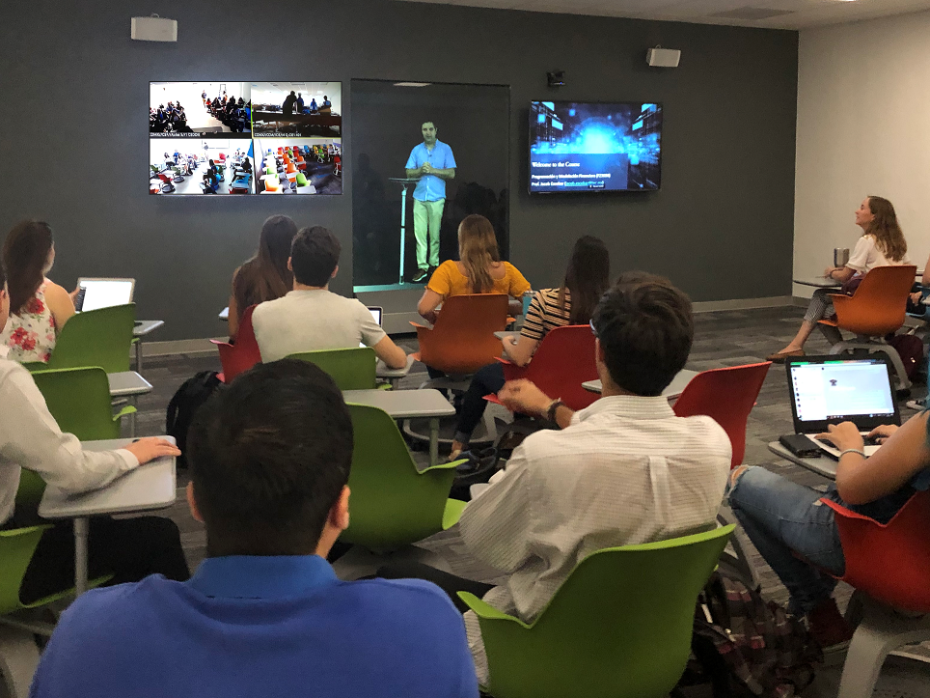I was recently asked: “What do you suggest we do to get students back in the room?” The University of Portsmouth, where I work, and our colleagues across the sector (regardless of institution type) are wrestling with fundamental issues around tackling student engagement and attendance.
Post-pandemic, many universities maintained flipped-learning practices, meaning students must engage with resources (pre-reading, short snippets of lectures, etc) before coming to class, where they then engage with peers and staff in face-to-face sessions to make sense of the subject matter for themselves.
Indeed, student feedback asked us to continue recording sessions and using virtual learning environments (VLEs) for providing resources – as we found in our QAA-funded Differing Perceptions of Quality of Learning project and in institutional course and module surveys. Across the sector, however, there has always been scepticism about recording sessions, in that many say it has the opposite effect on attendance.
- Resource collection: The post-pandemic university: how to serve the Covid generation
- What is student engagement?
- Your starter for 10: how can a TV quiz format help courses avoid extinction?
Recently, a colleague in the sector, Peter Olusoga, tweeted a picture of his empty classroom – not a single student turned up to his session. While acknowledging all the reasons students might not be able to attend (work, caring, illness, travel time and costs, etc), he also highlighted “the small group stuff, though, the tutorials and seminars and workshops…that’s where you really need to be there to get any real benefit”.
The concern for the sector is, as Dr Olusoga described it, “the fact that everything is online in advance (accessibility) means students can make a decision ahead of time as to whether a session is worth their effort (in their opinion!)”.
During recent wide-ranging discussions with course leaders at Portsmouth, we examined how putting our Content Capture Policy at the centre of what we do would be helpful. We don’t capture everything – it’s not a Lecture Capture Policy. That is, content capture is not about simply recording, by audio or video, an entire lecture. It’s about capturing the essence, the “core content”, but not the whole, using one of a range of appropriate methods, for all types of sessions. That might simply be a few key takeaway points on a PowerPoint slide, a set of brief notes, a padlet or a short interview between two people about what was learned or covered in the session. These can sometimes be produced by students themselves, meaning that staff and students can share the “capturing” of the “core” content.
Thankfully, there are students who recognise the benefits of small-group and interactive sessions, as reported in focus groups in the QAA project: “Increase (the) number of seminars and decrease having notes on slides and having lecturers reading from them. It is hard to keep focusing when content is being read off the slides. It is more engaging when there are questions as it keeps us challenged and active.”
Clearly, the pedagogy only works if the pre-work is provided and undertaken and then used in interactive sessions. So, it is crucial, as the course leaders highlighted, that we get the students in the room and prepared to engage. A bit like going to the gym, you don’t get fit just by being there, you have to engage to get any benefit.
What is the benefit? In the same QAA project, interactive and practical elements were seen as an integral part of quality learning, while engaging/motivating teaching, and interaction with staff, were seen as essential parts of quality teaching. Recordings of teaching materials were highly valued by students surveyed in the project (73 per cent of the overall sample) but, tellingly, students perceived that formal tasks and activities with other students contributed the least value (only 38 per cent saw value in these).
Clearly, the perceptions here need to change if the pedagogy is going to work in our learning and teaching “gym”. So, we’re going to have to go back to basics with our students and explain the fundamentals of what is an important part of their learning.
As a starting point, course leaders engaging students in a discussion about non-engagement is valuable. Sharing feedback from students, for example, can help explain what good teaching and learning is and how it enables the learning that will help them achieve the best outcomes.
Another familiar situation is that some students attend but are not engaged and, being solely exam-oriented, only ask questions such as: “What will be on the exam?” Students with transactional approaches to learning often have resulting unhappiness with teaching approaches.
In our course leader discussions, we therefore touched on assessment. Might it be necessary to implement more continuous assessment to drive student attendance? we wondered. Not necessarily, others thought, and shared examples and suggestions for in-classroom activities, authentic assessment and group activities that build throughout the term.
For example, an innovative approach at Portsmouth is the Hacking for Ministry of Defence module in which, over 12 weeks, students experience self-directed, independent and group learning, engage with VLE and Common Mission Project resources, arrange interviews with Ministry of Defence officials and other external interviewees, attend weekly lectures and talks by guest speakers, access additional materials and guidance through social media channels and give weekly presentations to, and get feedback from, staff and peers. The module finishes with a group presentation of their solution to a real-world Ministry of Defence problem.
Now well into our second teaching block, for us, like many institutions, having begun the academic year by making clear our expectations and reasons for student engagement and attendance, and seeing a good start – like resolutions to go to the gym – some students’ motivation has waned.
So, working with our education developers, we must now make our recorded lecture snippets and resources “unmissable”, which help make our teaching sessions and rooms “the place to be”. It is not necessarily going to be comfortable for staff or students, but the first day back at the gym after a break seldom is.
Harriet Dunbar-Morris is dean of learning and teaching and reader in higher education at the University of Portsmouth, UK.
If you found this interesting and want advice and insight from academics and university staff delivered direct to your inbox each week, sign up for the THE Campus newsletter.




comment2
(No subject)
(No subject)